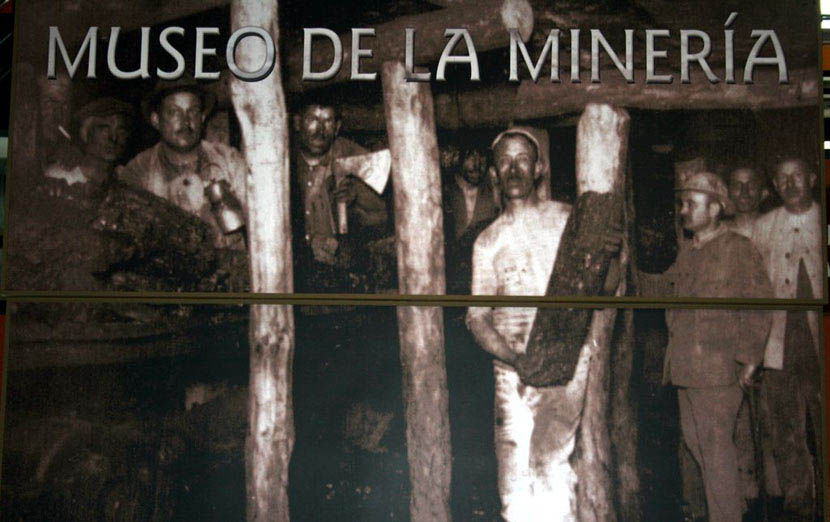
INTRODUCTION

Welcome to the Puertollano's Mining Museum. This audio guide will serve as an easy way to discover the city's mining history as well as the traditions and living conditions of the mine workers.
The guide has been structured to match the various zones of the museum: the ground floor, upper floor and image mine. At the same time, each block is divided into various audio tracks which will help you to obtain a better understanding of the museum's contents.
THE MUSEUM
Puertollano's Mining Museum is located in the North Shaft Park, location of the old North Mine which was the property of the Peñarroya Metal Mining Society. Construction of the northern shaft began in 1928 and the shaft remained in use until 1973.
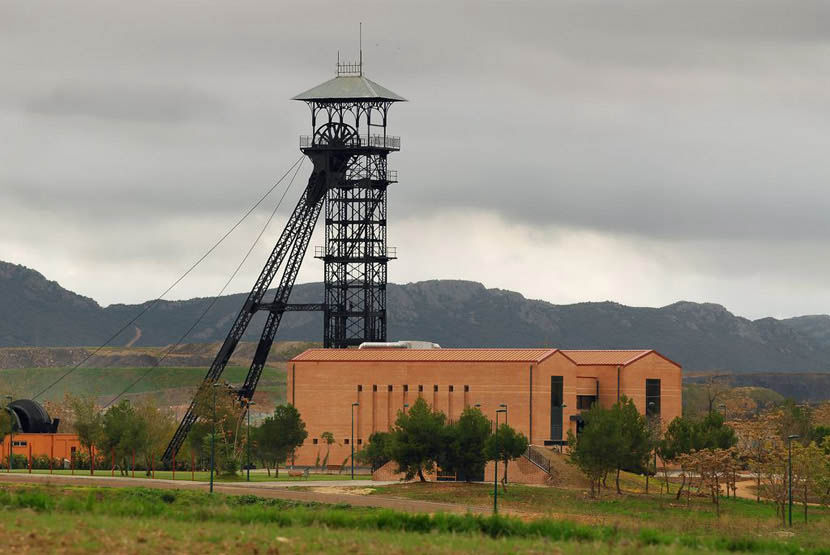
Once mining activity ceased here, all the machinery from the North Shaft was desmantled and the majority of the buildings demolished, leaving only the metallic headframe which you can see at the rear of the museum, and a part of the engine room. The museum's building you can visit with the audioguide is a reconstruction of an old mineral sorting workshop of the North Shaft.
PUERTOLLANO'S MINING SCULPTURE
The first person to welcome us to the museum is the bust of the “Miner of Puertollano”, a certified copy, made from the same plaster mould as the original sculpture made in 1909, by the sculptor “Julio Antonio”, located in Tarragona's Museum of Modern Art and belonging to a series entitled “Busts of a race”.
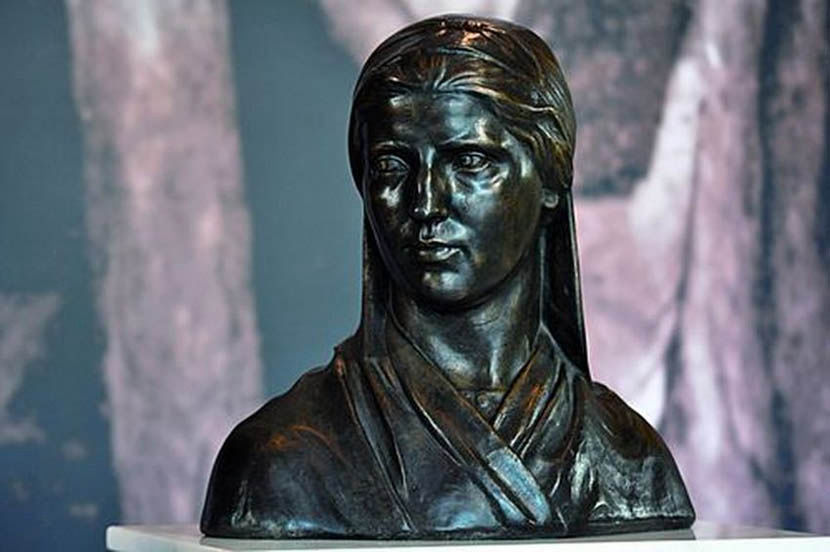
The sculptor produced this series of work in Almadén, where he lived for a while with his family and took advantage of his stay to produce a multitude of sculptures. During one of his trips to Puertollano he was taken by the sad look of this woman. He wanted to record for eternity, and to remind us through the medium of sculpture, of the effort and hardness of mining work, which women such as that we see here also carried out, over a century ago.
THE CARBON PERIOD
Let's go back in time with the audioguide 345million years ago. It was a period characterised by violent changes, big earthquakes and gigantic volcanic eruptions which gave rise to great mountain ranges and lead to a humid and temperate climate.
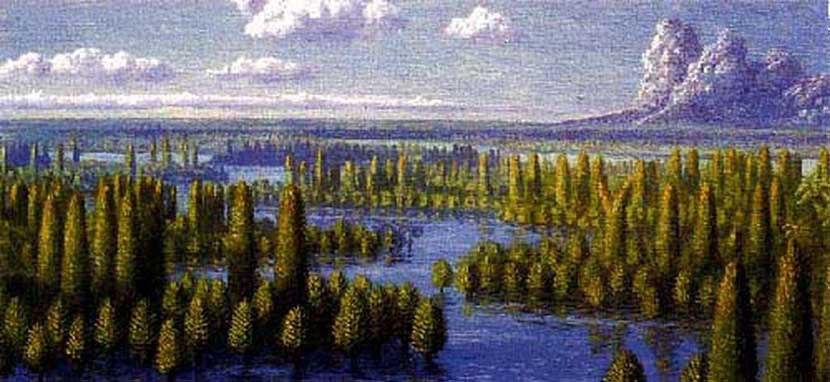
In the geographical area that we know today as Puertollano, existed a great lake between mountains, surrounded by thick bracken woods, rich in carbon, which explains the existence of carbon deposits in this basin. In front of the panels that you can see one can observe a recreation of a fossilised bracken trunk, more than 3metres high which was found in the Emma mine in Puertollano. The actual fossil is owned by ENCASUR.
COAL FORMATION AND DISCOVERIES IN THE BASIN
Coal, one of the most important fuel sources for man since olden times, is formed from the remains of ancient swamp plants, which, upon decomposing in mud, in so doing transforming into peat. Peat, when compressed, converts into a dark brown rock known as lignite. Under extreme pressure the bitumous carbon or coal is transformed into anthracite. Of the four types of carbon that exist (peat, lignite, coal and anthracite) in Puertollano the type that existed in the basin was coal.
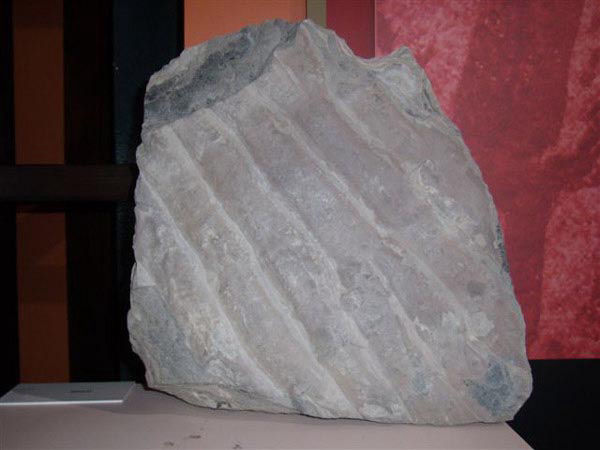
Another important thing to point out is the abundance of fossils. Some of them, due to their importance, are exhibited in the Natural History Museum in London. Without doubt the most common fossils here are the ripple marks, the traces left by the action of the sea on the rocks. In the Puertollano basin a large number of fossils of fish, ferns etc. have been found. Here we can see genuine fossils of the type we have mentioned here in the audioguide.
ANTIQUES CABINET OF THE COUNT OF VALMASEDA
The antiques cabinets were the beginning of current day museums. In these, notable members of society collected all those objects that the considered interesting.
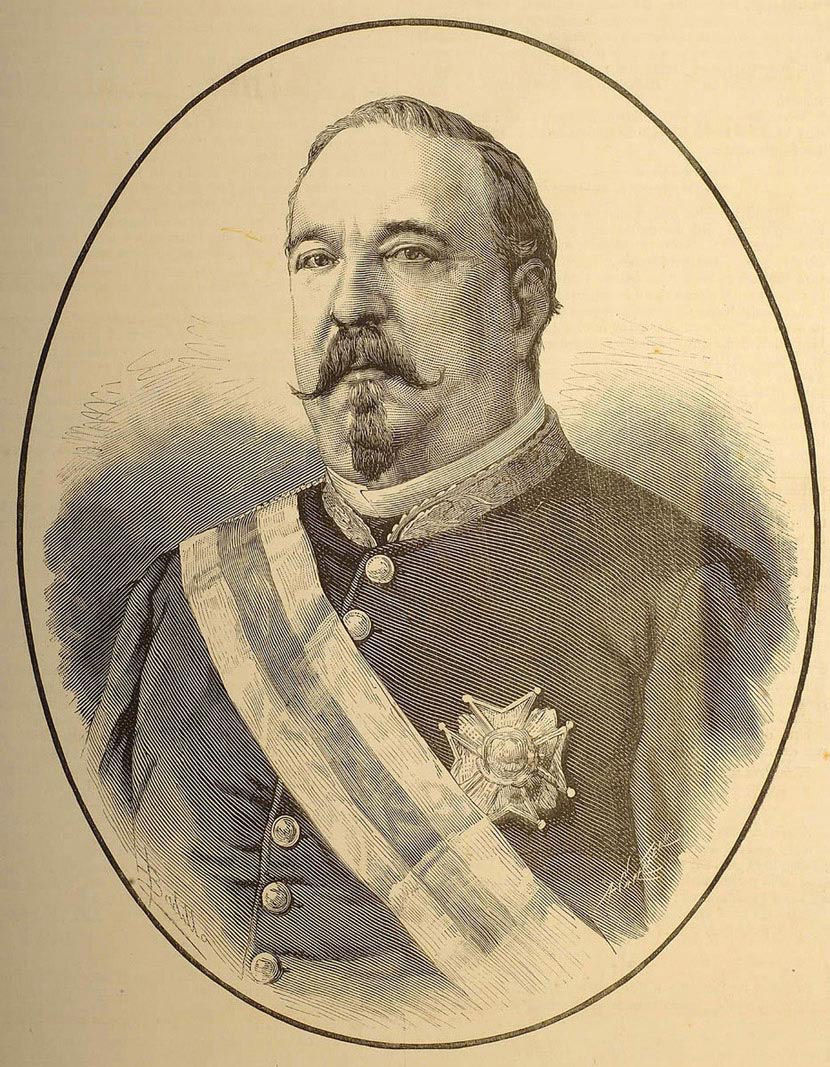
Sometimes, they housed fakes or pieces to which had been attributed characteristics very different to their true identities. The Count of Valmaseda, an important military figure in the Cuban war, thanks to his entreprenuerial spirit, was the most important business man when the mining of coal began here, founding La Extranjera, the first mining society based in Puertollano, in 1875. In this area of the museum we highlight the newspapers of the time, plans for competitions, and even a copy of a sabre toothed tigre's scull.
VOLCANIC ZONE
The carbon basin of the city is centred around the valley of the Ojailén River and occupies 48km2. Puertollano is located within the confines of the Valley of Calatrava Natural Region, an interesting volcanic region. Near to the city we can find various traces of different volcanic eruptions. The Herrerilla Volcano, the Castillejo River volcano in the basin's centre and the great basalt sieves near to the village of El Villar. This last bout of volcanic activity occured around 2million years ago and was very different to that which occured during the carbon period. In the photo which you can see in the panel with the audioguide, we find a panoramic view of the Ojailén Valley along with a small collection of the main volcanic remains from the area, particularly notable in their abundance are the basalt remains.
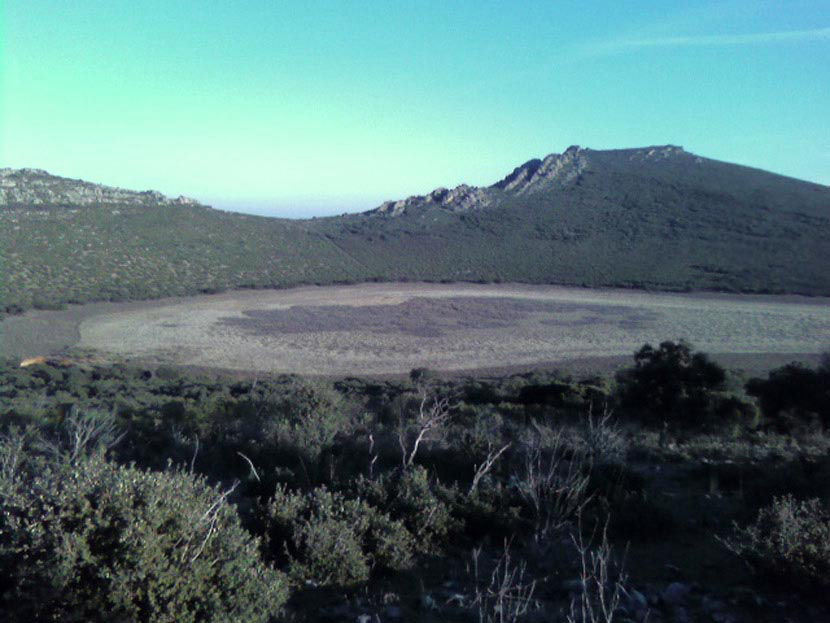
FOSSILS
Fossils are the remains of plants and animals that existed during previous ages, which have been captured in the rocks. The first really important fossils discovered date from 570million years ago, at the beginning of the Cambrian geological period. After this the first fish began to appear, some of which had lungs which allowed them to remain some time outside of the water. These were the ancestors of the first vertebrates, such as the fossil of the first European amphibians, which you can see with the audioguide in the central glass cabinet.
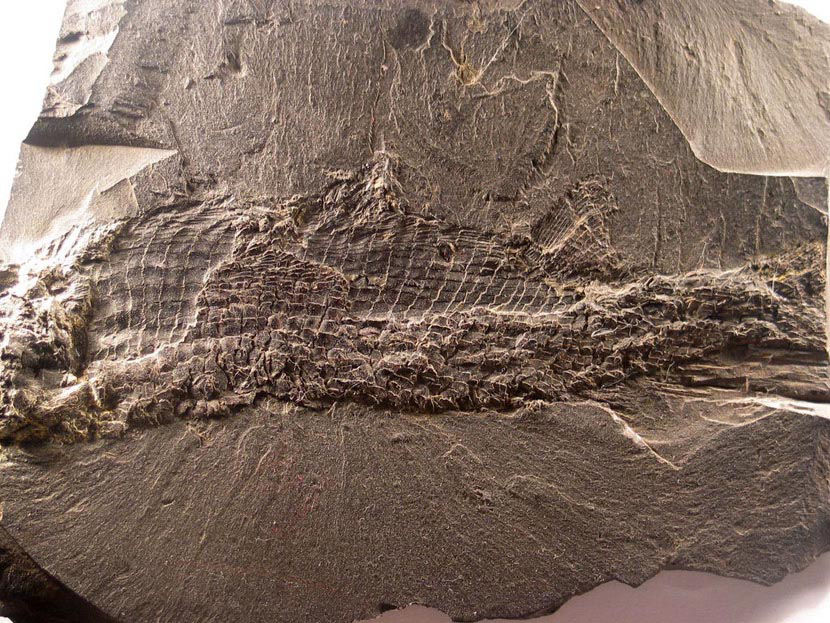
If we carry on through this zone we will see other examples of fossils such as those of the trilobites. In Puertollano various important examples of fish and amphibian fossils have been found. Another of the important fossils found in our basin is the replica of tracks of the “Puertollanopus Microdactylus”, which you can also see in the central cabinet. Finally, you can see some of the tools used in the archeological excavations such as a pick, a compass, a magnifying glass and pickets, the last of these used to indicate the scale of the objects found.
THE CARBONIFEROUS SEQUENCE
We arrive at the carboniferous sequence that represents a cut through the layers of the north shaft, more precisely through the Shaft of the Cross. The number of layers mined in the Puertollano basin was five, the first two layers were the best quality and were found at a depth of 130m below the first layer. In the carboniferous sequences, the carbon layers are interlayed within other sedimentary rocks and bituminous slate. The “carboneros” that we find in this layer refers to layers of coal that were not mined due to their narrowness.
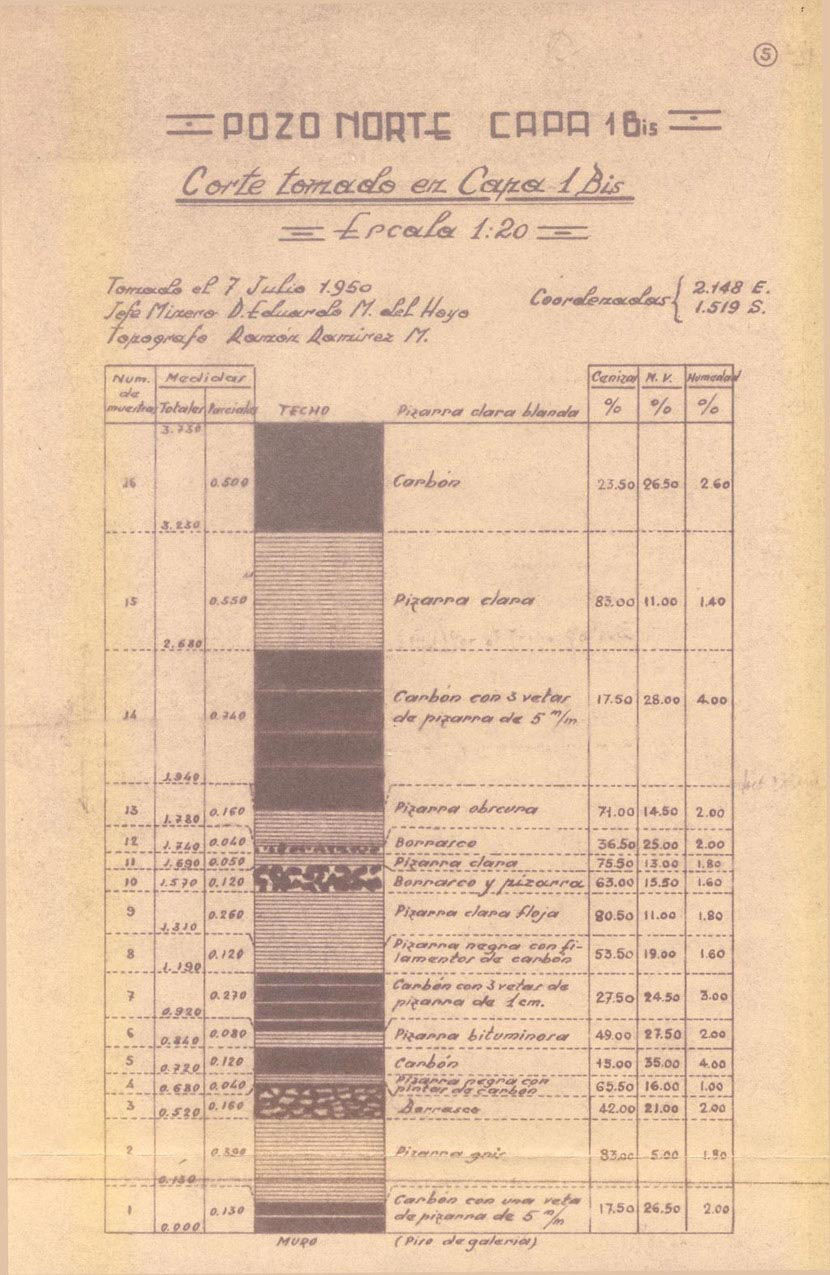
MINING'S HISTORY IN SPAIN
Lets enter with the audioguide into the area where we can learn about the origins of mining in Spain, in which we will discover how this activityn has evolved since its beginnings 5000 years before Christ up until the time of the Roman empire.
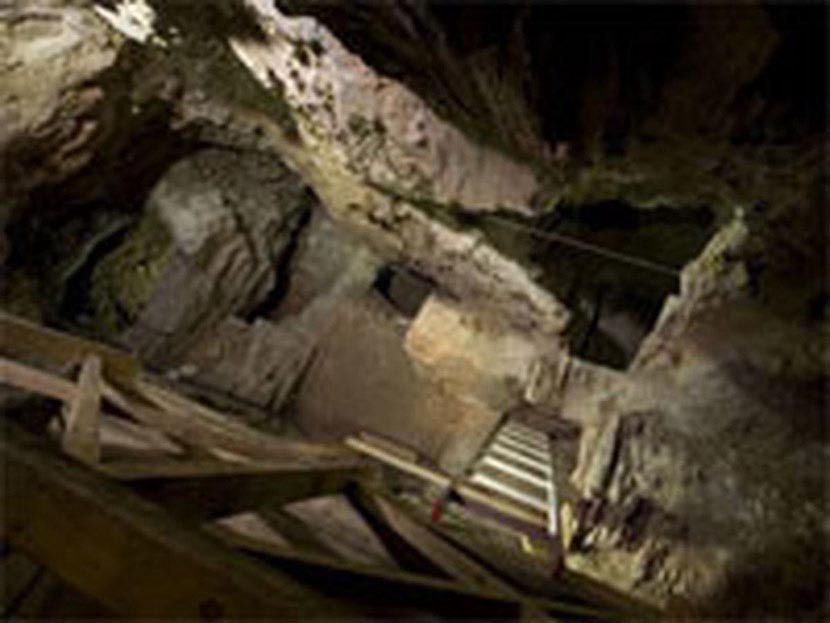
There is even evidence of mining taking place in the prehistoric cultures of the Paleolithic period, more of which we will see later.
CULTURES LINKED TO MINING
We begin this section of the audioguide by looking at the drawing in the first panel which depicts the oldest mine in Spain, the “Can Tintoret” in Gavá (Barcelona). The mine consisted of a complex of interconnected shafts and galleries. We can also observe primitive tools used in the extraction of minerals.
The following panel introduces us to the Argarica Culture, who mastered copper and silver working, producing extraordinary weapons and beautiful jewels. This culture dates from 1800 B.C. and existed in the area defined by the limits of Meseta, Almería, Granada and Jaén.
The Tartesios, also shown in this panel, are the first culture for which there is written evidence to support the fact that they explored under the surface of Spanish soil. There is evidence of the presence of this culture in the deepest levels of the deposits of Sisapo (La Bienvenida), a hamlet near to our ciy, located in the Alcudia Valley. The rivers Tinto and Tharsis, in Huelva, were the most important sites for gold, silver and copper mining.
We continue advancing in time and in the following panel the Fenicios are explained. These people arrived on the Spanish shore some 1000 B.C. They taught the natives new techniques to improve the exploitation of the mineral resources, but more importantly, they focused their attention on commercial exploits. Their centre of operations was in Gadir (Cádiz) and they created a big mining industry thatnks to a system of evaporation to extract sea salt. The greeks also established a foothold on the coasts of the peninsula, in areas of mining interest, such as Sierra de Lújar in Granada, Sierra de Gador and teh Sierra de Almagrera in Almería
Lastly this panel mentions the arrival of the Cartaginians to the peninsula, which took place following defeat in the first Punic War, and faced with the necessity of obtaining silver to pay economic reparations to Rome. They obliged the natives to increase the rate of silver production. At the same time copper mining began to decline, being replaced by iron mining.
Moving on to the following panel with the audioguide we come to the Romans, to whom we owe the first known legislation that dealt with mining issues, in which it is stated that mine workers should be slaves of the subjugated peoples. Particularly notable is the roman mine in the valley of Alcudia in the region of Puertollano. The Romans applied their knowledge of military and civil engineering to advance new techniques in the excavation and deepening of mines, in particular methods for the reinforcement of galleries and a system for the extraction of water through the use of water wheels and Archimedes' screws, a device invented in the 3rd century B.C. by the man who gave it his name. In these panels we can see drawings of a cross section of a roman gallery where we can make out in the upper part the use of waterwheels for the extraction of subterranean water. After the Roman period, mining activity in the area slowed until the middle of the 16th century.
Before leaving this area we should take a look at the panels showing the maps of the province of Ciudad Real which show the most important mineral deposits, and also the glass cabinets which house examples of minerals unique to this area.
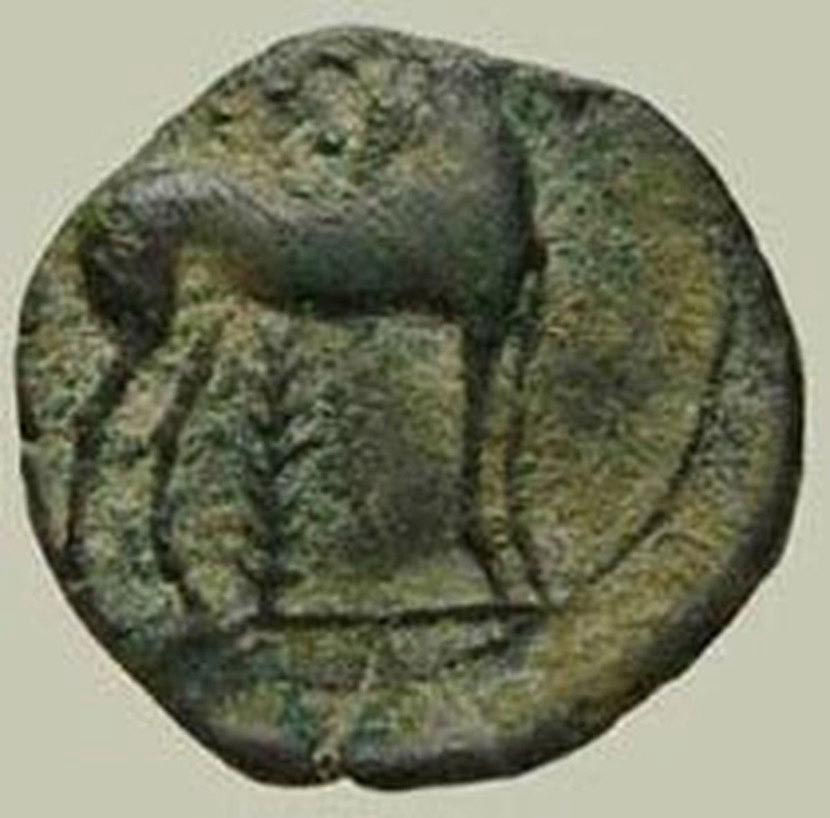
THE BEGINNINGS OF PUERTOLLANO. FROM PREHISTORIC TIMES UNTIL 1348
The first documented settlement of the Ojailén River valley is from the early-Paleolithic period. Here we highligh the arquelogical deposits of Castillejo de El Villar, a photo of which we can see in this panel, and which was inhabited from 1200 B.C. and where materials have been found dating from the Bronze age to the periods of islamic and christian occupation. The zone was of particular strategic importance in terms of controlling the fertile lowlands of the River Ojailén and its natural resources. In 1995 it was declared a site of cultural interest due to its Council of Communities of Castilla de La Mancha. Dating from this primitive period we can see with the audioguide in the cabinet a large collection of stonework, which has been useful when studying the habits and techniques of the inhabitants of the area at that time.
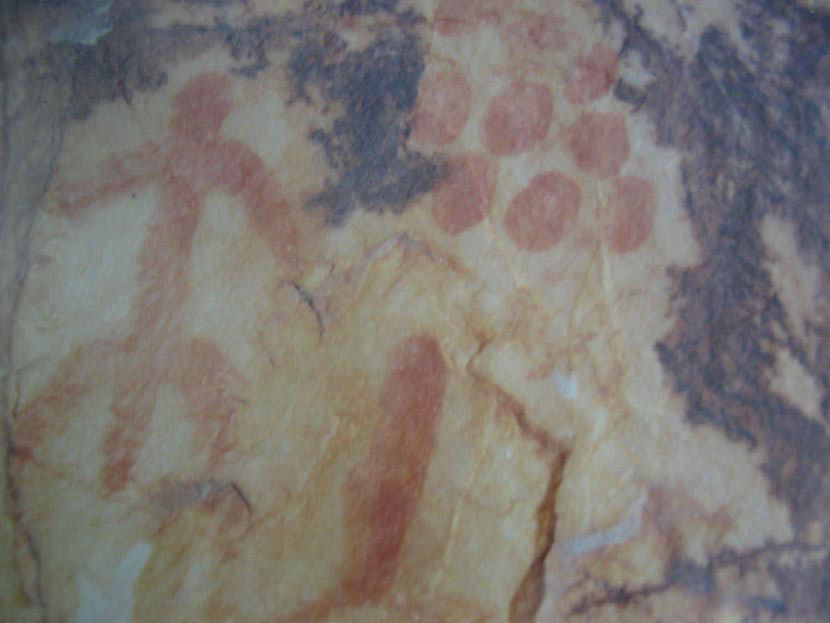
The folowing panels show places and discoveries found in the region dating from the Bronze age, the chalcolithic period and the iron age. We draw your attention to the photograph of mosaics of the remains from La Bienvenida and the schematic paintings from the Ojailén Valley.
HE FOUNDING OF PUERTOLLANO
During the middle ages, whilst under muslim control, the Puertollano region found itself in the centre of a battle for strategic dominace between christians and muslims As a result of the victory of Alfonso VIIII in the battle of Las Navas de Tolosa in 1212 the situation changed and groups of people began to arrive to settle permanently.
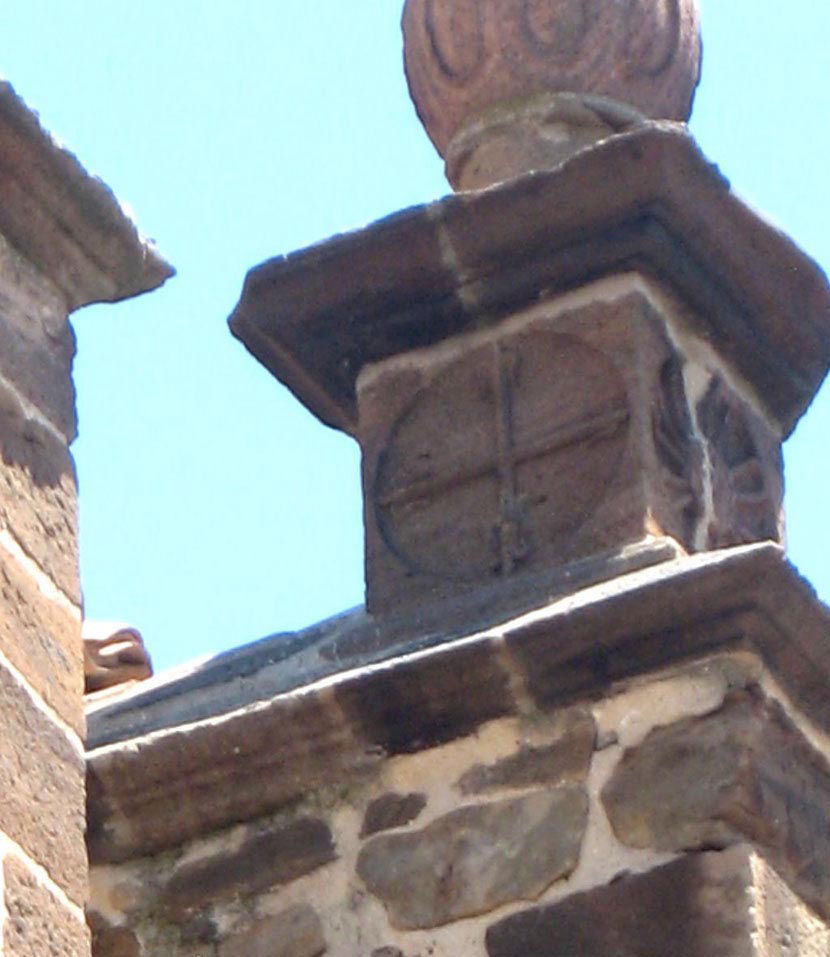
The birth of Puertollano is comparable to the process of repopulation which took place in Castilla in the 13th century under the direction of the Order of Calatrava, whose original cross we can see in the image shown in this audioguide, and which can be found in the church of the assention in our municipality. 1245 marked the first appearance in written records of a place by the name of Portus Planus.
In 1348 the black death plague that swept through Spain and the rest of Europe made itself felt in Puertollano, and only 13 families survived. These families pleaded to the Virgin for a miraculous intervention, each year they sacrificed 13 cows and gave the resulting meat to their neighbours. This tradition continues to this day and has been declared a Regionally Important Bank Holiday, celebrated annually on the eighth of the Ascention in May. Bearing witness to this tradition we can see various photographs of ovens used in the preparation of this meat, along with black and white photographs of the celebration of the Holy Vow where a big stew is still cooked in earthenware pots.
PREINDUSTRIAL PUERTOLLANO, FROM 1348 TO 1873
Before the discovery of coal society in Puertollano was based on fishing and agriculture. It hardly changed its way of life up until the industrial period ushered in by the discovery of coal in 1873. The municipality was bigger in those days, reaching the borough of Ventillas and taking in Hinojosas de Calatrava and Cabezarrubias del Puerto.
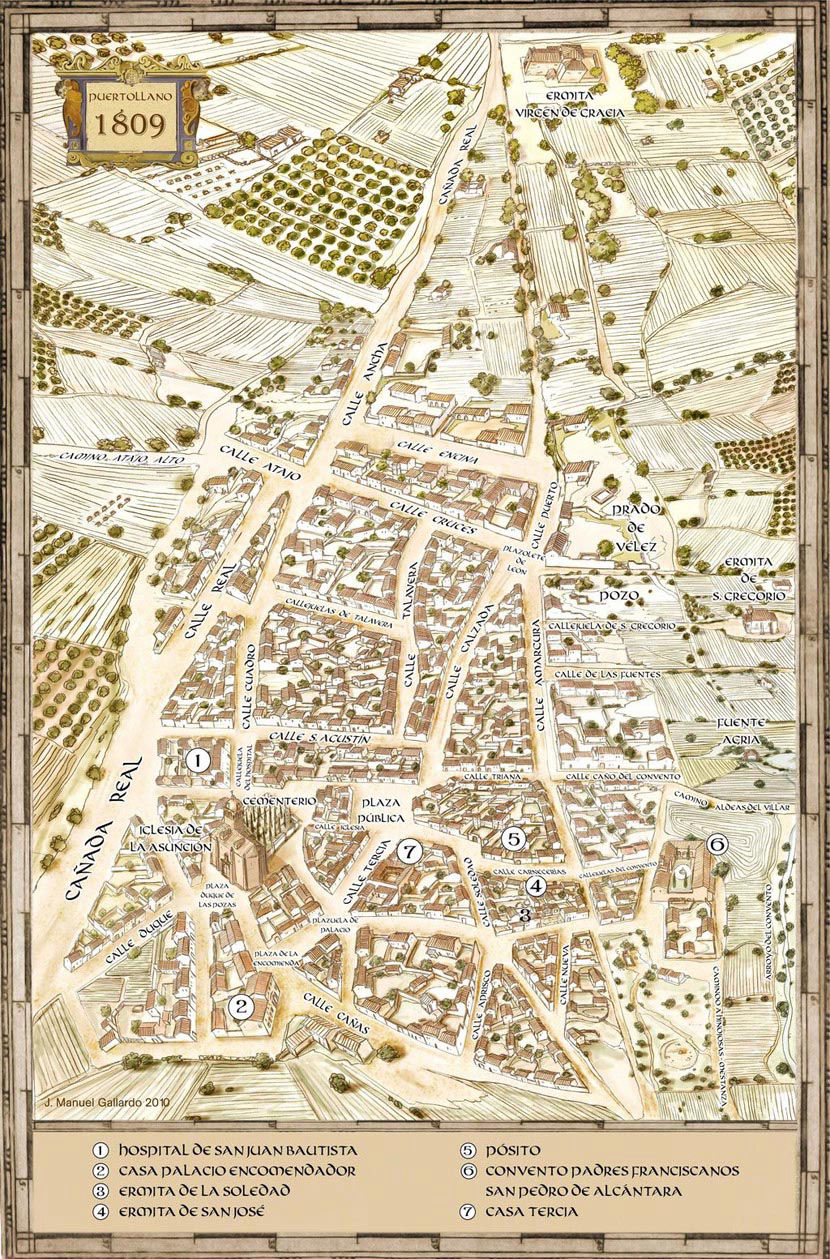
The main crops were cereals and the fields were situated mainly in Egido de San Gregorio, today the Paseo de San Gregorio. Here we can see the remains of cork collected from cork oak trees, another of the traditional industries in the area, along with tools for work with beehives.
The was an important pottery industry during the 16th and 17th, famous for its water jugs and “Vow” pots such as the example we see here. We can also see photos of the method of transport used during the time along with a photo, in the lower border, of a “chozo”, a typical dwelling of shepherds. In the 16th century the production of woolen cloths, which obtained prestige thanks to their perfect craftsmanship.
Another of the panels in this area reflects the growth in the population of Puertollano, which has varied, not reaching a stable level until well into the 17th century. In the final exhibition cabinets some photos from the beginning of the 20th century are displayed, along with a general plan of the development of the city's historic centre that you can see with the audioguide. Various farming implements used in olden times can be seen in the ethnographic area, for example a disc type thresher or the measures used for grain.
THE PIG SLAUGHTER
The slaughtering of a pig constitutes a ancestral rite, through which chorizo, blood sausage and other sweetmeats are obtained. On the 23rd of January it is customary to celebrate the “Day of the Chorizo” in the city, people travel to the green areas nearby to sample the speciality prepared around this date.
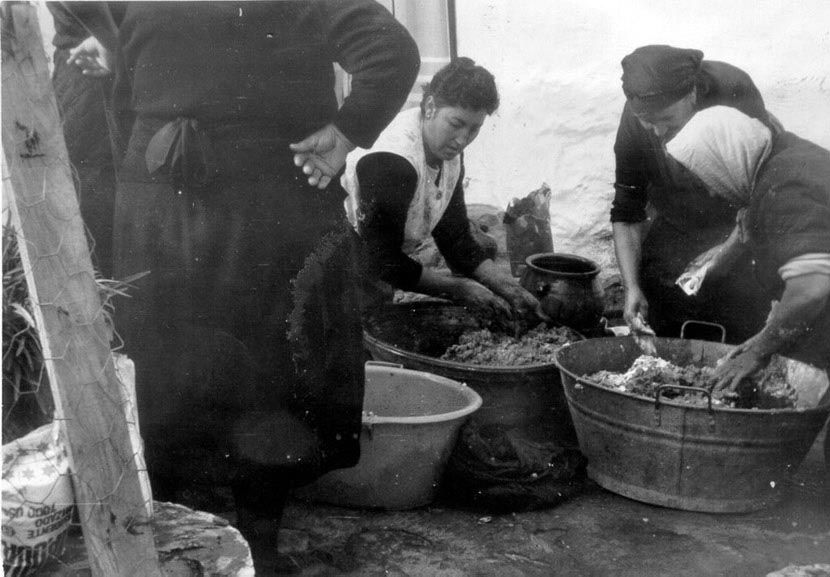
We can see amongst the various objects a sausage making machine, utensils used in the slaughter of the pig along with a shepherding items and a table used in cheese making. You should also take note here of the model of the Delio Windmill, the last windmill to stop working in the region, near El Villa next to the waters of the river Ojailén. This windmill began working in the 18th century and ceased its activity in the 1940's when electricity arrived.
THE FIRST FLOOR. DISCOVERY. PIONEERS. 1873-1923
Before immersing ourselves in this fascinating era we should take a look at the examples of common objects of the time exhibited in the glass cabinets here, such as the typewriter or original share-ownership documents from the mining societies, amongst other things.
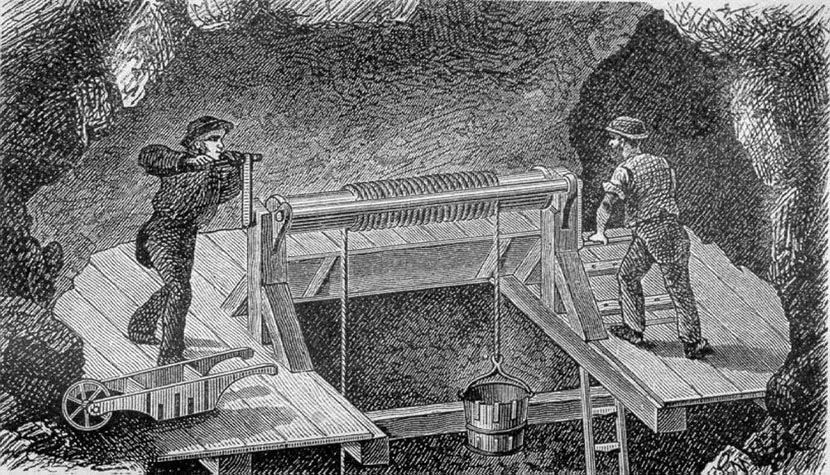
In the first panel we encounter with the audioguide, we can read about the social transformation involved in the change from a fishing-agriculture based society to an industrial city with more than 20000 inhabitants.
With the arrival of mining to the city came thanks to the visit to the area of some engineers, from the Malaga based company of Loring, Heredia and Larios, in 1873. These engineers observed by chance pieces of fossil-containing rocks in a waterwheel near to the municipality and from this they deduced that they found themselves in an area containing coal deposits. Straight away they dug a small shaft in which they found coal at a depth of 25metres. The first mine registered in the Puertollano basin was La Extranjera. Later, as activity in the area increased, other notable companies began such as Charbonnages de Puertollano, Peñarroya (the most important and powerful) and Hulleras de Puertollano, amongst others.
MINING'S EARLY DAYS. 1873-1923
The early times in the mine were very difficult. The materials necessary for the correct functioning of the mine were lacking. The miners worked under very difficult conditions; sicknesses such as Silicosis, the great danger posed by explosions and tunnel collapses were daily risks for these workers. In 1916 the destillation of bituminous slate began, the second mineral that we find in the basin after coal.
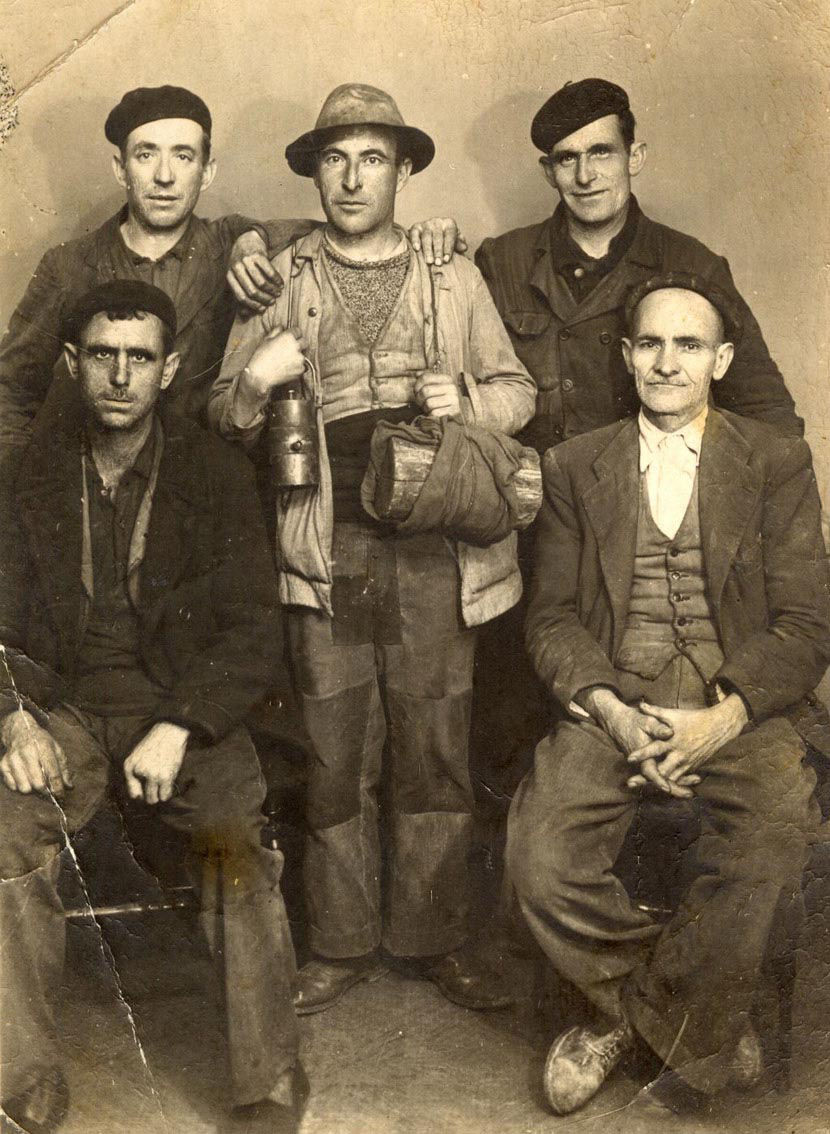
The following panel shows how impossible it was for the miners to have a decent home. They lived in poor neighbourhoods and built their homes with their own hands. Furthermore, the typical clothing of a miner is described here, including their “taleguillas” (small cloth bags in which they carried their food), “carburas” (carbon lamps used both inside and outside of the mine) and we see them with a lump of wood on their shoulder, the same as those used to reinforce the tunnels, from which they removed splinters in order to ignite the portion of coal that came with their job. We can see some moments captured as the miners left or entered the working shaft.
The last panel in this section of the audioguide shows photographs of the main buildings in the city, following the modernist style of the time, such as the Recreation Circle (Círculo de Recreo), the council offices and the Grand Theatre. Here we should also highligh the importance during this time of the water spring and spa which brought Puertollano global fame.
THE RAILWAY AND THE MINING BASIN
A significant network of railways was developed in conjunction with the development of mining activity in the area, both within the mine and also private initiatives that established rail links to transport the minerals between the Alcudía valley where extraction took place, to Puertollano. In 1890, the Peñarroya Metal Mining Society was awarded the concession to operate the rail line between Puertollano and Almodóvar del Campo, which was inaugurated in the same year.
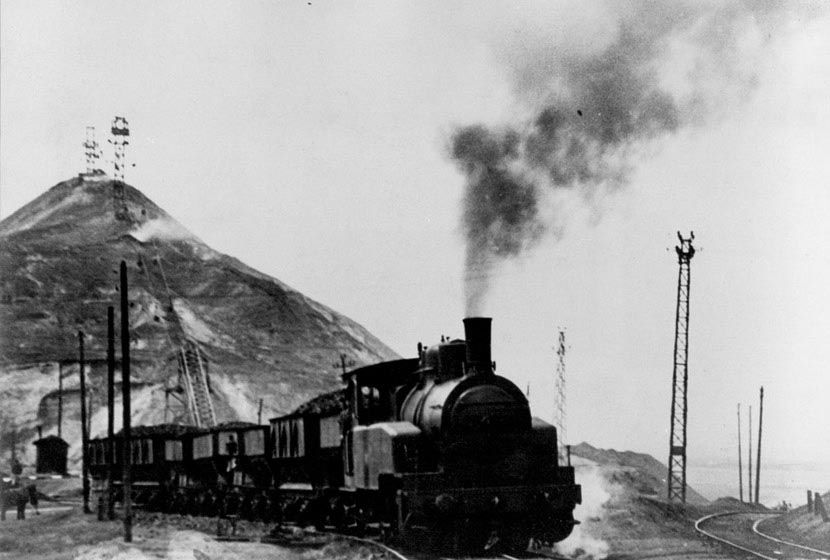
With the arrival of the “Great War” in 1914, coal production in the Spanish peninsula increased at a dramatic rate, due to the needs of the fighting countries. When the war ended, the crisis of the 1920's began. Despite various obstacles, work to complete the rail network that linked the municipality of Conquista in Cordoba with Puertollano finished in 1924: and on the 3rd Decembre, 1927 electrification arrived to this stretch of rail. The importance of a highly interlinked rail network to the mines of Puertollano was such that the mining basin possessed more kilometres of railways than some small european countries.
The following panels we can find with the audioguide remind us that it was not only the exterior railway that was important. Beginning in the 1920s, locomotives began to be used inside in the mines, first steam engines and later electrically driven machines. We can see photographs of examples of these machines used inside the mine such as the Deutz or the Berry, which we will also see in the image mine of this museum. Take a moment to note the reproduction of a ticket office from a train station, destination Calzada de Calatrava, with its unique clock, and the prices and journey time that corresponded to this trip.
MODEL RAILWAY
The model that you see before you with the audioguide is the largest in Castilla- La Mancha. It is a scale reproduction of the railway network in Puertollano, covering nearly 20 square metres, and offering a detailed representation the old railway network that used to exist in the city during the 1960s and 70s. You can make out the stations of RENFE, FEVE and of the “little train of Calzada” and their outbuildings.
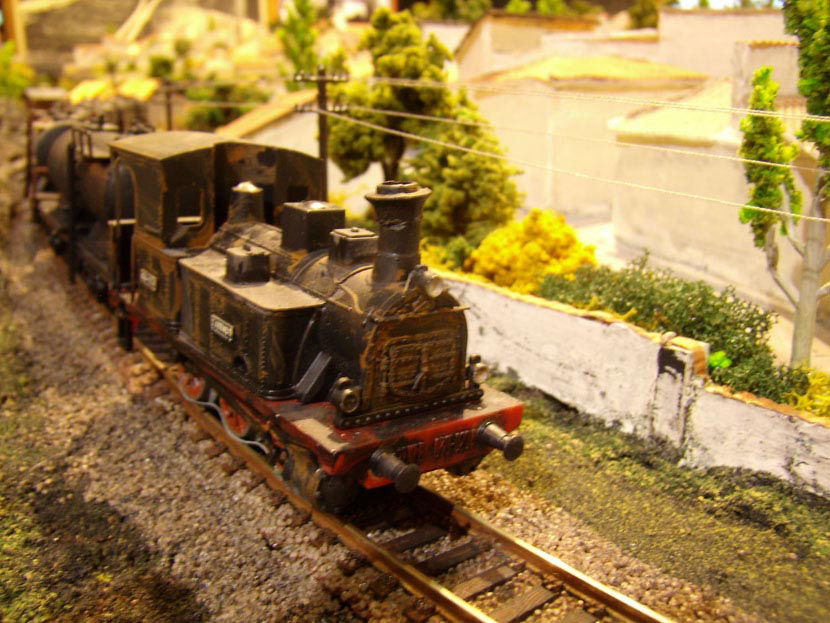
The model is modular mounted on iron supports protected by a wooden cover with an analogue-digital control system controlling 100metres of track. Another important fact refers to the four nerve centres:
1) The RENFE station. Situated in the centre of the model, to the left of the control panel. RENFE used a gauge of 1,67metres (wider than the european width and other national railways). On this track ran the express train from Madrid to Ciudad Real to Puertollano to Badajoz from where it linked up with Portugal, which used the same width track, leading this track gauge to be called the “Iberian width”.
2) The “Narrow” Station (with a track width of 1 metre) situated opposite the previous station, at the foot of the Cerro de San Sebastián. The train that operated on this track ran from the mines of San Quintín - Almodóvar del Campo – Puertollano – Conquista – Peñarroya – Fuente del Arco. At 244km, is the second largest stretch of narrow gauge railway, only surpassed by the stretch from La Robla to Vizcaya, at 355km long.
3) The “Little train of Calzada” station, situated between the bridge at Cuatro Caminons (the current bridge for the AVE) and the Virgin of Grace hermit, at the foot of the Santa Ana hill. The main stations on the line were Puertollano – Calzada de Calatrava – Moral de Calatrava and Valdepeñas. Its gauge was even smaller than that mentioned previously, being as it was only 75cm wide. Its narrowness and the sharpness of its corners lead to various derailments and limited the speed that trains could safely travel at.
4) “El Terri” (located on the left of the model) was the slag dump where all the waste of the Peñarroya complex was discharged. It is located at the exit of Puertollano, on the road to Córdoba, in front of the Apartadero de Calatrava, where the Conference and Exhibition centre of the city is now located. Here we can see how the wagons dumped the mining waste onto the colossal mound. Recently this zone has been conditioned to permit access to its summit on foot or by bicycle, from where we can contempate the magnificient views of the city and the mining basin.
USES OF COAL
Coal has various uses. It is used in forges and foundries to smelt metals or as a fuel in the process of production of tar and jewellery such as jet derived from lignite, or sculptures.
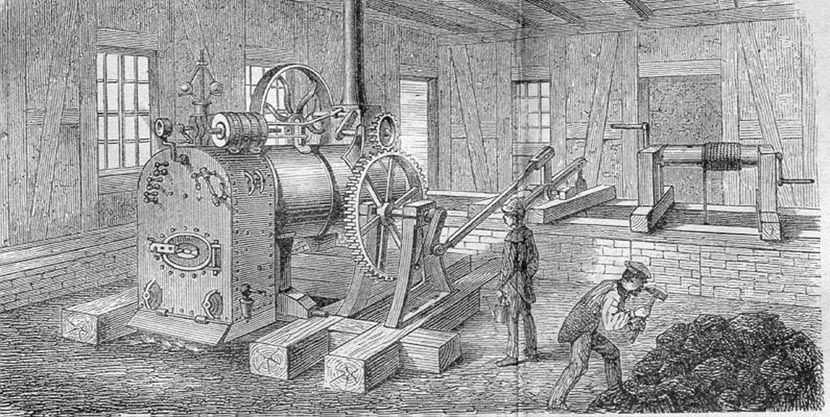
The next panel highlights the importance of coal in the second half of the 18th century, when it became one of the foundations of the industrial revolution. It was a vital source of energy in steam engines. In this panel we can see with the audioguide some machines which used coal in order to work such as locomotives and wagons, etc. In terms of objects representative of the time in this section we have a kitchen and coal-fired stove, chiselled sculptures, jet stones and sheets, amongst others.
THE MINER'S CORNER
Before heading on to the next area we will cross a corridor with the audioguide where various typical miner's tools are displayed, items such as a helmet and a lamp, along with photographs of workers of the city's mines. The group of working miners included both men and women and even children.
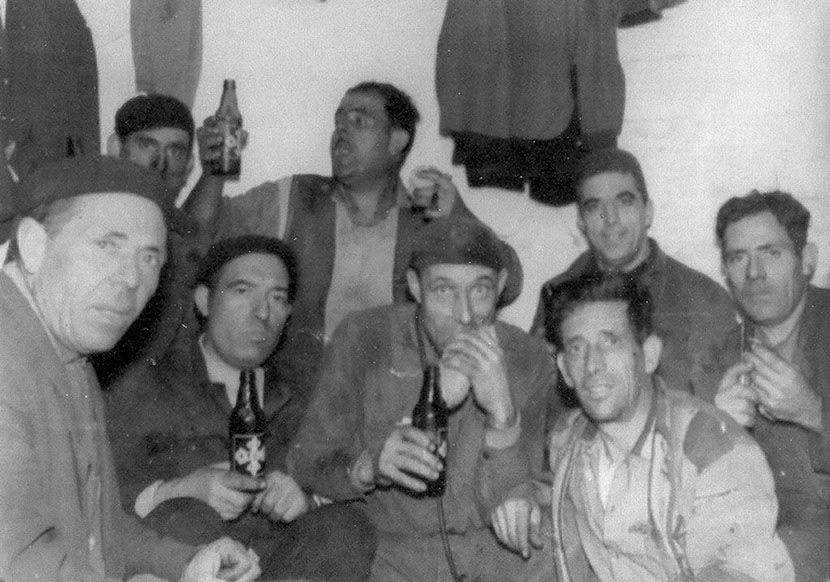
Women and children always worked on the outside of mines, in the washing areas and in the selecting sheds, whilst the men could work both in the exterior and interior of the mine. Some children lied about their age in order to be able to work inside the mines, because the daily wage was higher for workers inside the mine.
MODEL AREA
We head on now to the area of models made by ex-workes which explain how the machinery used in the mine worked. We begin this section with a reproduction using moving models of many of the typical tasks in a mine, oil fillers, scrapers or locomotives used in the mine.
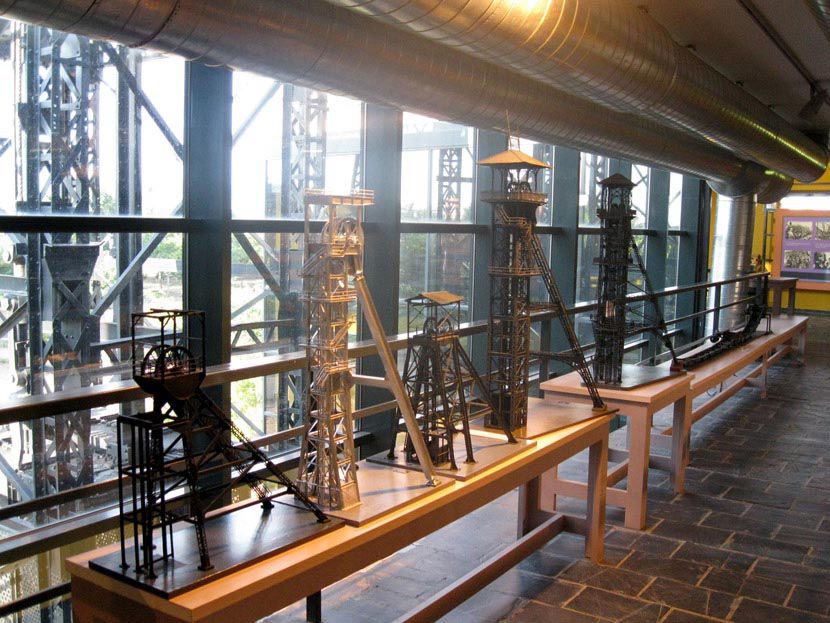
This area shows through photographs the activities and jobs carried out in the mine, pickman, donkey drive, reinforcer, wagon driver, topographer, watchman, etc. Lastly the audioguide shows us a cabinet containing various industrial mining implements along with items from the everyday life of the miner such as lighters, work uniform, etc.
PARTIES AND LEISURE
Despite the long and tough working days, the miners still had some time to enjoy leisure activities and participate in village festivals. The miners adopted as their patron saint, Saint Barbara (whose image we see in this panel), due to the constant danger that their job entailed and the relationship of this saint to explosions. The saint's day is celebrated every 4th December.
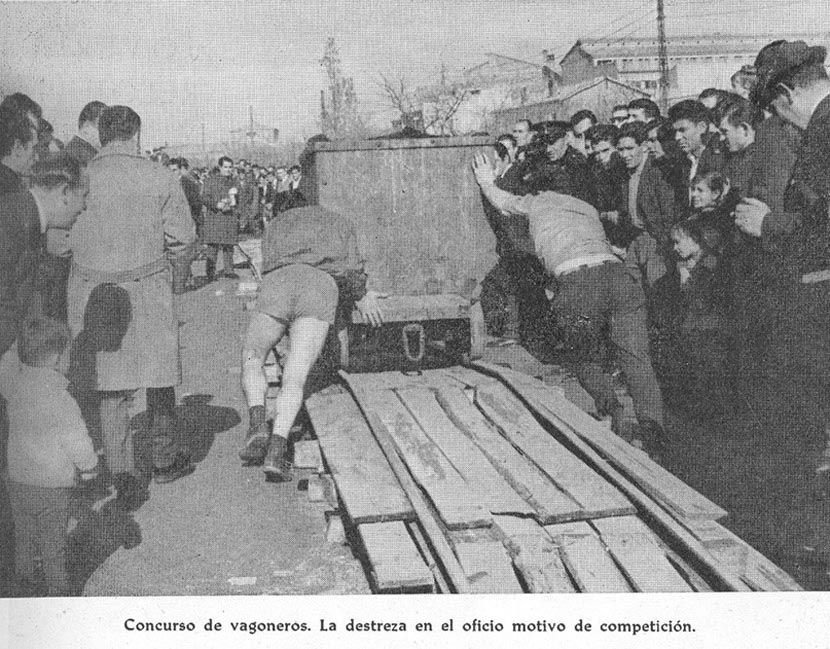
Following the audioguide, in another of the panels we see represented the competitions that were organised and participated in by groups of miners. Over the years this “fiesta” grew in importance and the day eventually was considered a holiday. An anecdote, it is worth pointing out that a number of “slight” accidents in the mine increased dramatically in the days leading up to a festival or fayre. Take a look at the old photographs of the May Fayre, along with an original poster from 1913 for a bullfight.
THE CLOAKROOM. SOCIAL CENTRE AND MUCH MORE
Now we arrive with the audioguide at the area which recreates a typical miners' changing room, with lockers, benches, clothes etc. A social centre where the workers shared experiences and anecdotes, making this the most intimate area of the museum visit.
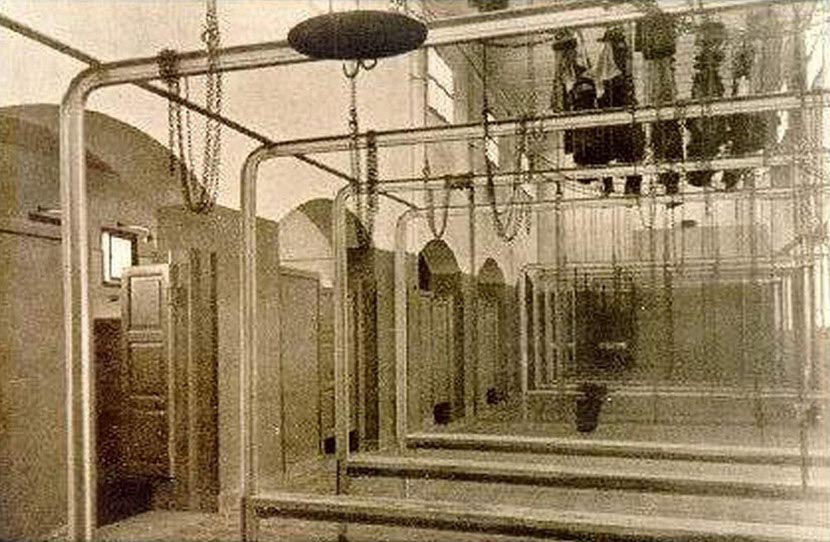
At the end of the 19th century the first signs of associations and unions of workers in Puertollano began to appear, which fought to achieve better working conditions in such a tough environment. The growing development of the mine made conditions harder for the working class. The difficult working conditions lead to the first episodes of social unrest, creating an awareness that took the form of guilds, unions and political parties.
These organisations were genearlly short lived until 1910, year which marked a change in direction for the workers' organisations of Puertollano. Here we would like to point out some examples collected of the first health and safety measures put in place in the mine along with union publications from the beginning of the 20th century.
THE MINE
WELCOME
During this visit with the audioguide we take a look in chronological order showing how the use of the mines of the Puertollano basin has evolved over the years.
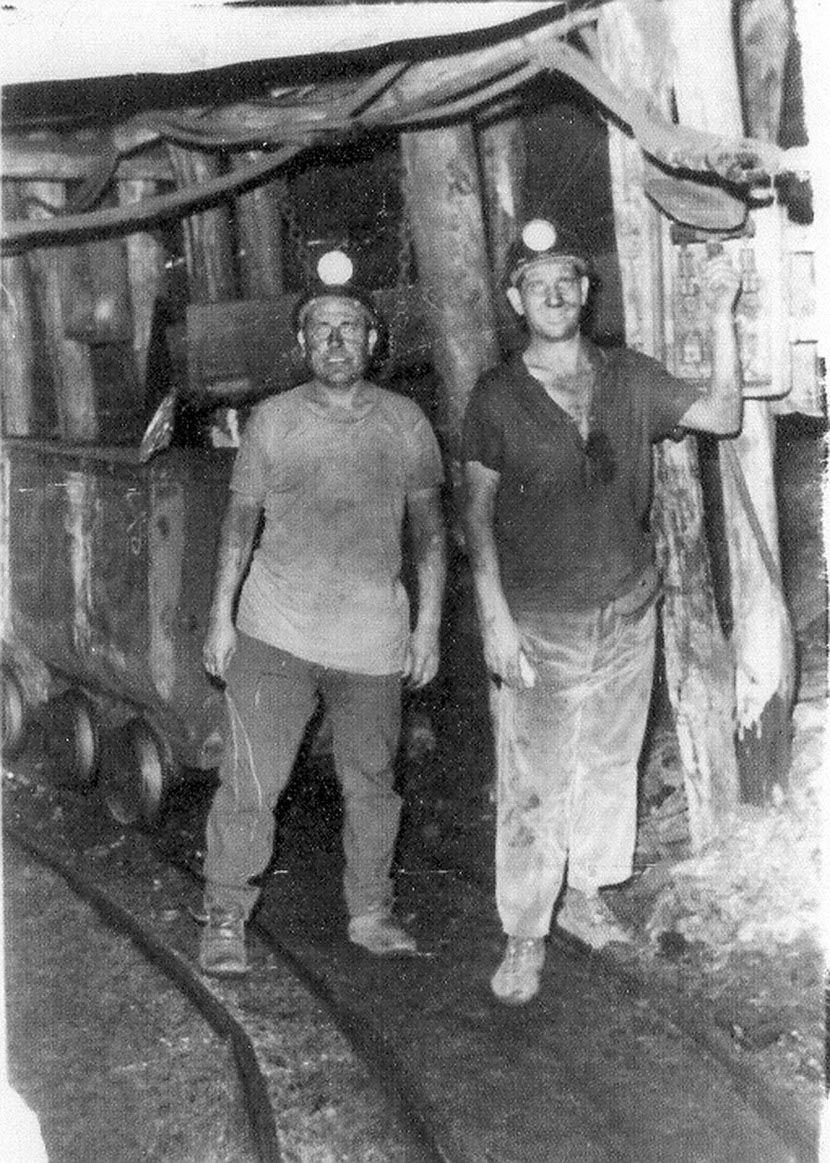
After that we head towards the gallery where we will be able to see “in situ” the mine workings as they were in different epochs. Descending in an elevator towards the heart of the mine, we reach a depth of 205m below the surface, the same distance that the miners who worked here had to descend every working day in this shaft. The mines in Puertollano were working during the period from 1875 to 1975.
THE QUAY
Welcome to the inside of the earth. We have descended with the audioguide via an elevator that simulated the sounds that the miners would've heard when they descended in the mine's cage, and we arrive at the area that was known as “The Quay”, where the horizontal gallery coincides with the vertical shaft.
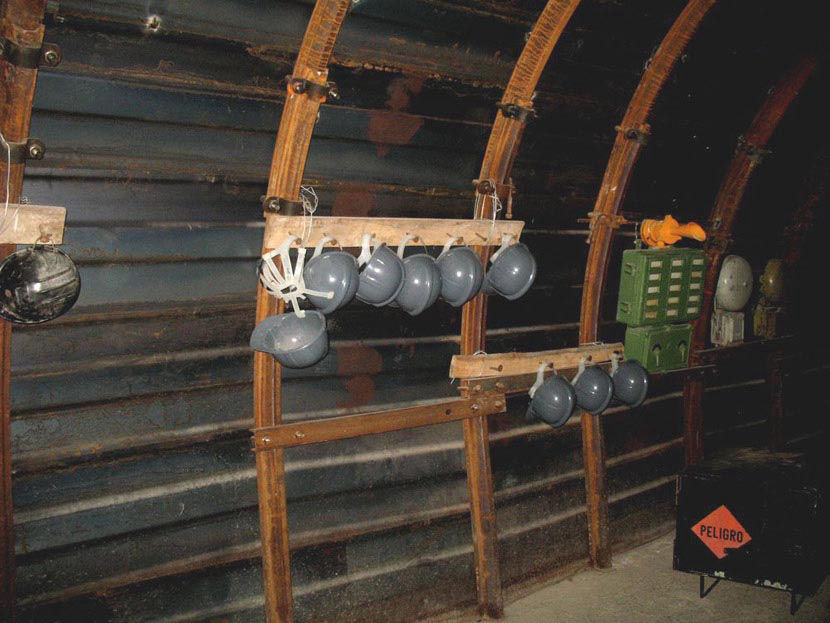
This is both the entrance and the exit to the mine, everything enters and leaves through here, from workers to wagons, machines, ventilation, etc. We can see details typical of the time such as systems to enable comunication with the outside world or the signalling bells which can be seen on the right, the intercom and order boards. The quay is reinforced with metal to avoid collapses, and on the left-hand side there is a return track to enable the unloading of wagons laden with minerals extracted from the mine.
MAIN GALLERY
We begin to walk with the audioguide through the main gallery and we find ourselves in the period of 1873, the year in which coal deposits were discovered in Puertollano. Two years later, the first mine works began. This main gallery is double tracked, originally reinforced with eucalyptus wood, a wood known to resist well in humid environments, with the aim of keeping water out of the zone and avoiding rockfalls.
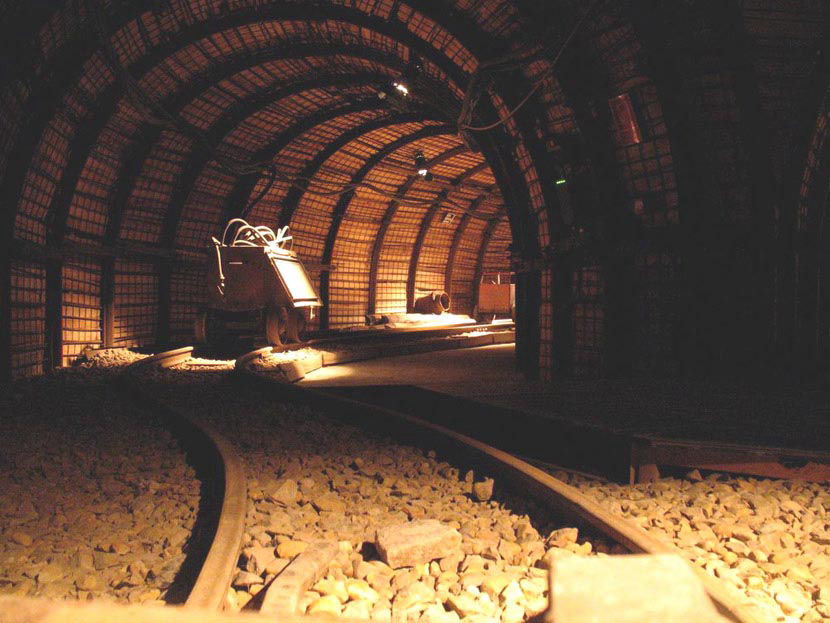
THE MANUAL COALFACE
We arrive with the audioguide at the coal face, that's to say the excavations that take place in the galleries, where we can see a miner using a drill. The driller was the person who created the whole in which the explosives would then be placed to be detonated and so enable the extraction of coal. The holes were 2metres deep and were drilled every 10cm. We can also see in this area other tools used in the mine such as picks and spades, which were the property of the miners so as to encourage them to take good care of them and not to lose them in any mine collapse! To excavate they used picks, and to load the wagons they used the shovels.
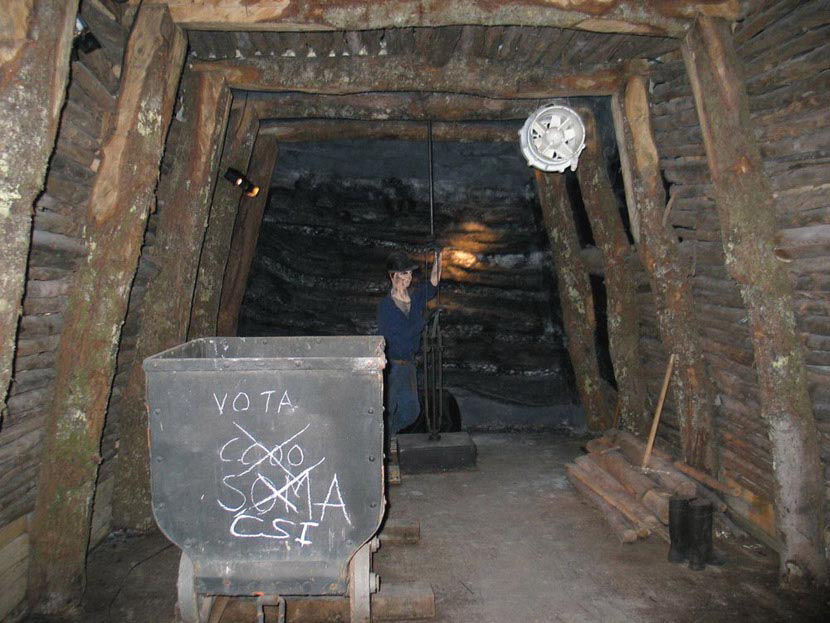
The wagons were drawn along the tracks in the gallery thanks to manual labour as well, the miners had to pull them, unless they had a mule available for the purpose. Mules were so used to walking the same routes and to drawing the same loads all the time that, if the were coupled to a wagon which weighed more than usual the mules refused to move until the load was reduced to normal.
THE MECHANISED COALFACE
We continue our journey with the audioguide until we arrive at the mechanised coalface, where we can observe a modernisation in the methods used to extract minerals. We find ourselves in a more modern age, given that in 1912 the Peñarroya Metal Miners Society is fromed and there is a gradual mechanisation of the tasks in the mine. Fans are introduced which help purify the air in the galleries, the first transporting machines and the reinforcement is all metal, replacing the wood which we saw earlier. The drilling, advancing and reinforcement continue, what has changed is the way of transporting and loading coal into the wagons.
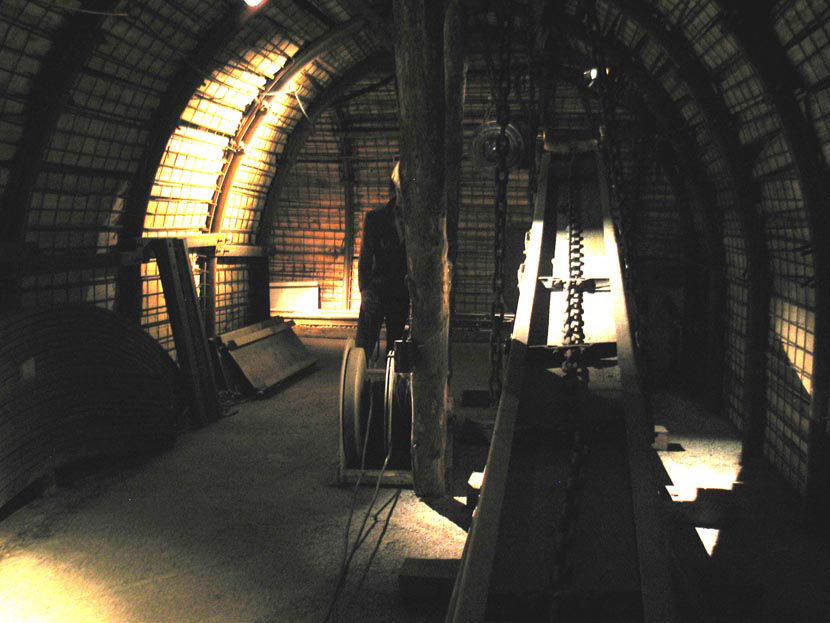
We see in this area a miner using a scrapper, a new method for carrying loads, and also a panzer, an armoured transporter. The wagons are no longer towed by mules but by steam-powered engines.
THE BITUMINOUS-SLATE FACE
Now we come to where bituminous-slate is being extracted. In the mining basin of Puertollano two types of minerals were extracted: coal and bituminous slate. Actually, in this particular shaft, the north shaft, only coal was extracted, but there were many shafts in the basin from which bituminous-slate was extracted, this gave rise to the petrochemical complex that exists in the city to this day. Slate is a type of stone and as such, with it's tough outer layer it could only be removed via explosion. These type of faces could give rise to the illness silicosis, due to the fact that the explosions needed to extract the slate were more powerful than those used for coal. In an attempt to reduce the likelihood of injuries to miners, compressed air and water were injected into the holes, in order to convert the dust to mud and so reduce dust accumulation in the gallery.
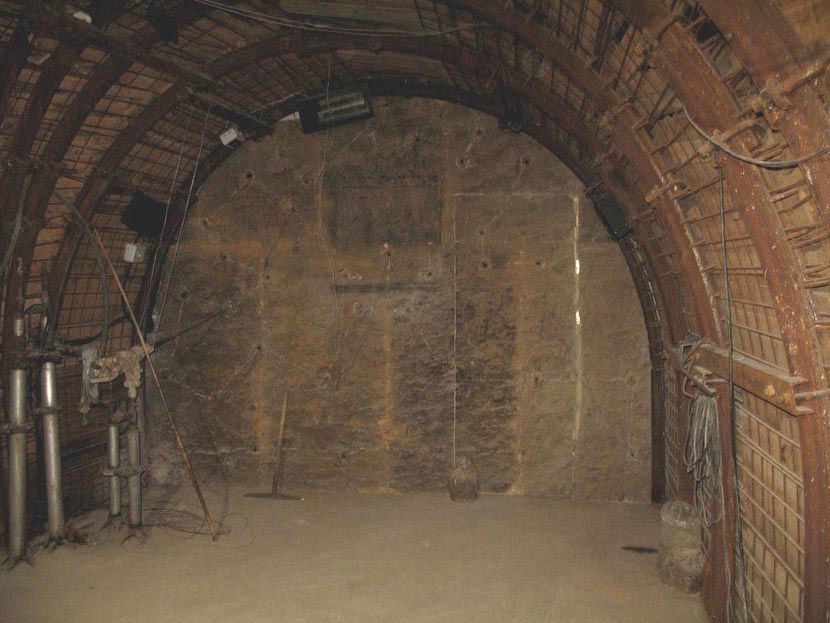
Another of the dangers to which the miners found themselves exposed was the presence of the gas “Firedamp”. Before any detonation a special lamp was used to check for the presence of this gas, if so it was necessary to well ventilate the area in order to avoid especially large explosions and consequent collapse of tunnels. Before the existence of these Firedamp detecting lamps the miners used birds, left at ground level, which would die if there was a build up of Firedamp in the tunnel, the miners could then take evasive action. We can see the drillers at the face, and also a diagram explaining a particular detonation technique and all the components necessary to carry out a detonation. Take a look at the cables running from the dynamite which lead to a scaffold where the detonator waits to activate the explosion. The visit with the audioguide continues in the next section.
EXTRACTION SYSTEMS
From now on we won't see fronts or excavations, rather methods for extracting the minerals, which we can think of as the second role of the mine, after that of the excavation. The methods we will see range from chambers and pillars to more mechanised methods
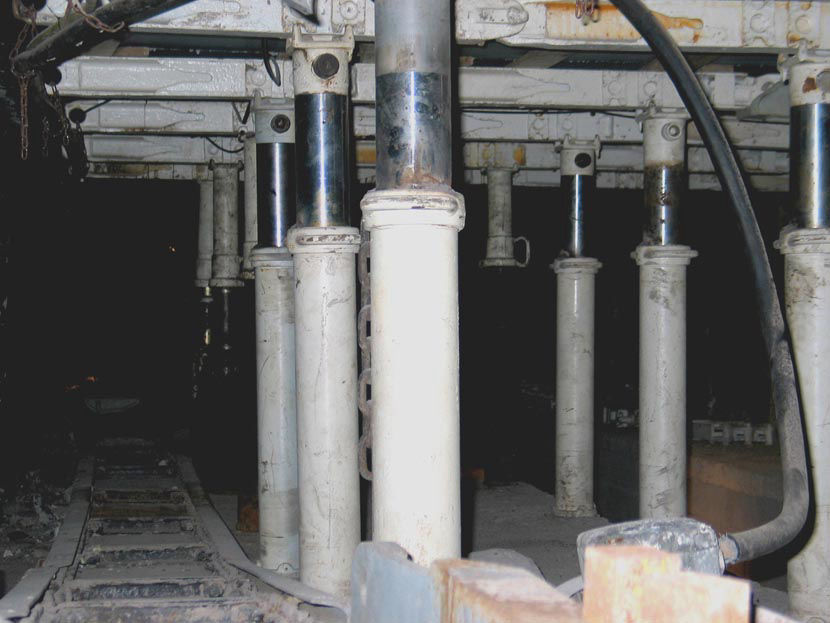
V SIEVE
We arrive at various extractions performed with sieves, the first of these known as the V Sieve. This refers to a hole in a mezzanine floor of the mine through which the minerals are thrown on route to a lower floor, from where they are taken out.
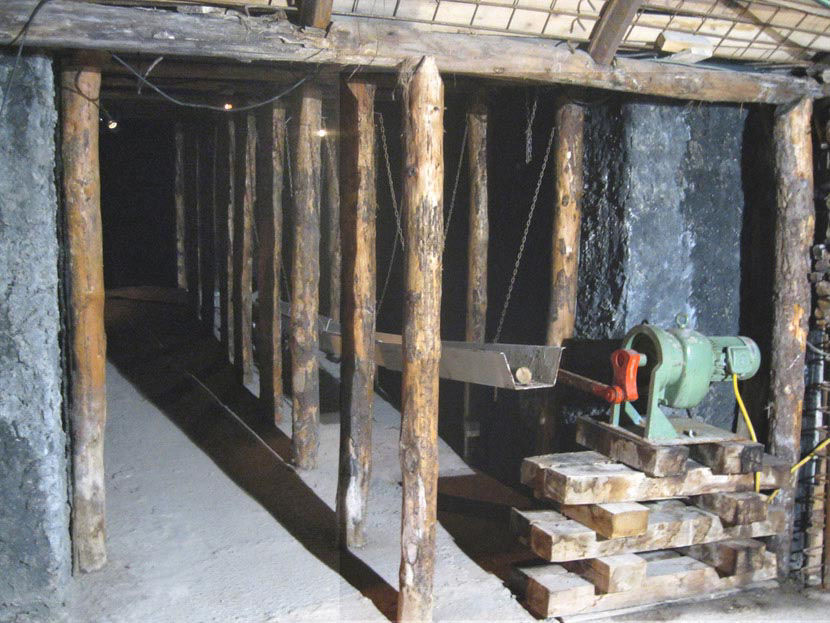
Coal if extracted using a pick or drill and collected in the V Sieve, the vibration of which shook the coal. This type of sieve is typical of the Puertollano mine basin. Its V-shaped form enabled work on both sides. The wooden reinforcement used was temporary, that's to say it was only left in place during the time that extraction was taking place in the gallery. The planks were recovered to be used in the next coalface. The technique of chambers and pillars involved digging galleries both length and widthways so as to extract a square-shaped layer of coal. The coal was extracted “backwards”, from the furthest end of the gallery moving towards the front, leaving some blocks of carbon untouched so that they might act as supporting elements.
THE DUCK BILL
We lead on to an area of bituminous slate extraction where we can see with the audioguide a fixed scraping blade and a type of sieve known as a duck's bill. The fixed scraping blade which we can see cuts both frontally and sideways along the slate front, seperating the lower part.
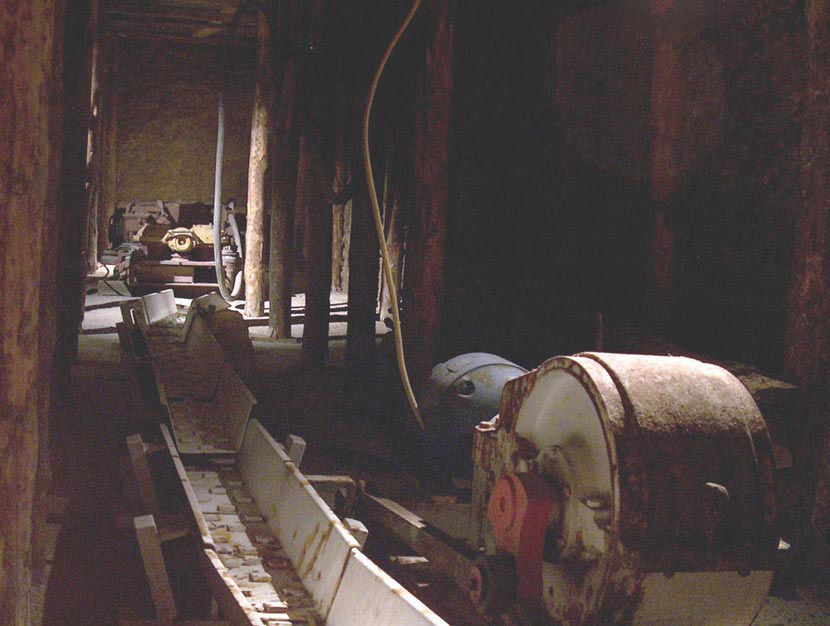
To recover the load the “Duck Bill” sieve was used, the head of which could move horizontally, unlike that of the V-sieve. The material fell into the sieve and was transferred, via the vibrations of the sieve, to an armoured transporter, which, once loaded with the material, carried it via various galleries until it arrived at the point where the wagons were loaded. Now we start to see machines used to cleave the stone, the scrapers. From this point on the systems of extraction changes again, we move into a more recent phase, associated with controlled collapse which began at the end of the 1960s and the start of the 1970s. These are the last two techniques used in the mines of Puertollano.
THE LONG FACE
Here we can see a long face flooded. The face is the place where the team of miners worked, a team which changed throughout each day, as they advanced through the galleries extracting material.
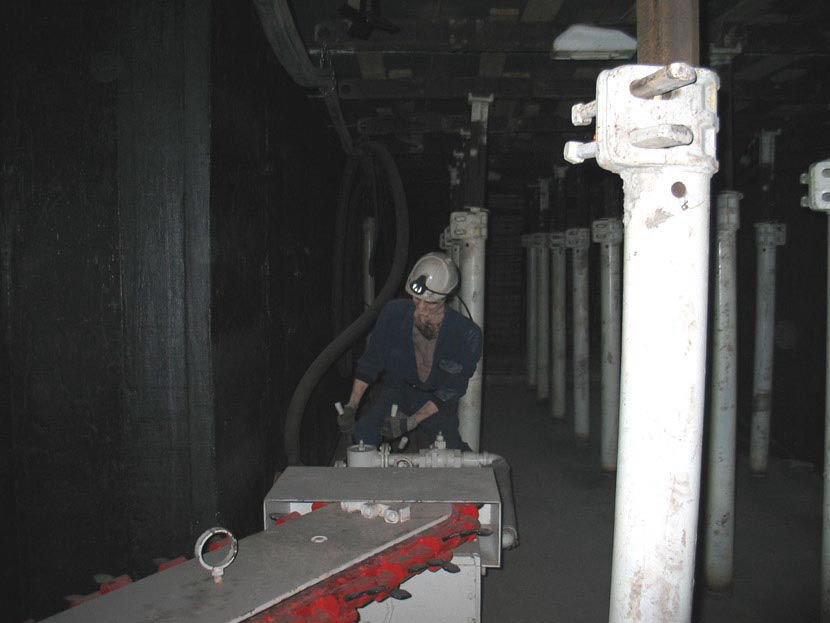
From this point on only the working zone was reinforced, the rest was left to flood so as not to cause any danger. The supporting rods are metallic, held in place by friction, and the company made the miners recover the rods due to their high cost. The scrapers are still used, but they are know mobile and work in combination with the transporters. We can see with the audioguide the mobile scraping blade on the armoured transported and the supporting friction pillars.
THE DEUTZ LOCOMOTOR
Here we come across the old internal Deutz engine that precedes the latest systme of extraction that we are going to see. This engine is from 1962, made in Germany and ran on diesel.
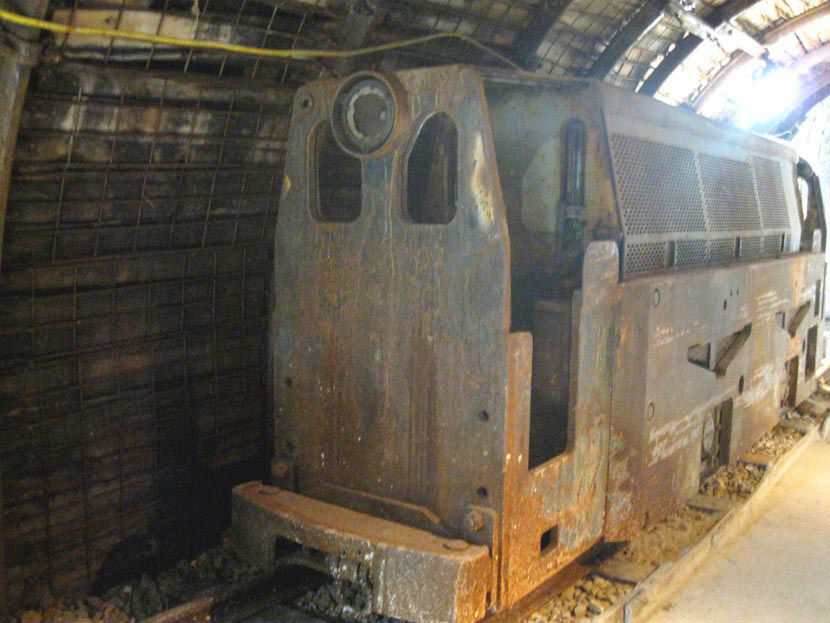
It weighs 12 tonnes and therefore had to be lowered to the gallery in various stages as not all of it fitted in the lift cage. It was capable of pulling 90 wagons, each weighing between 700 and 1000kg. It is a double chamber type engine so that it can rotate in both directions without having to be spun around. It contained a sand store from which sand could be thrown onto the tracks to avoid the production of sparks which could potentally produce a fire. This sand store was used to heat the miners' food due to the fact that it reached high temperatures.
SLOPING PLANE
The system you can see with the audioguide was a cheaper system than the wagon lift for moving the wagons out of the mine. Once outside a crane lifted the loaded wagons, emptied them and returned them. The same crane was also used to raise and lower staff.
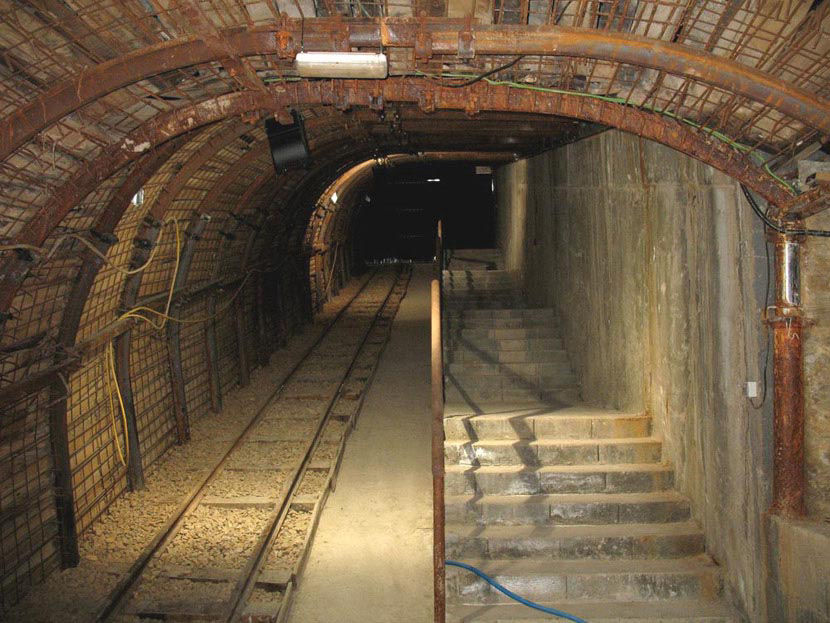
THE THIN LAYER
The second method of seperation is the brush, mounted on an armoured transport and hydraulic pillars. We find ourselves with the audioguide here in front of a thin layer, little more than a metre high from where we can see confined working spaces. Here the miners worked on their knees or lying down and practically naked so as to better support the high temperatures.
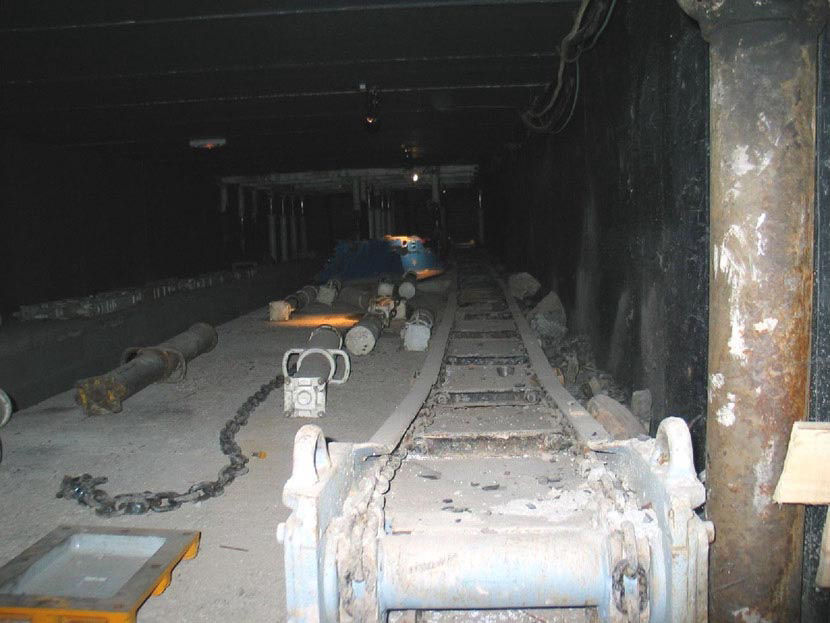
The bruch was also used for extractions which, using knives, ripped of the layers and literally brushed them. The brush was aligned parallel to the transporter or panzer, pushing the coal towards it, from where it was carried towards the extraction gallery.
At the same time we see that the type of reinforcement has changed, it's still metallic but now the supports are hydraulic, the fluid being oil and acting upon jacks which adapt to the size of the layers.
THE WALLED GALLERY
We continue our route with the audioguide and find ourselves in the walled gallery. The galleries were walled due to the danger of flooding, fire and the build up of Firedamp gas. In the walls we can see a circular window through which the water level could be observed. If the miners determined that the water level could cause the gallery to flood they immediately walled up the gallery in order to be able to continue working.
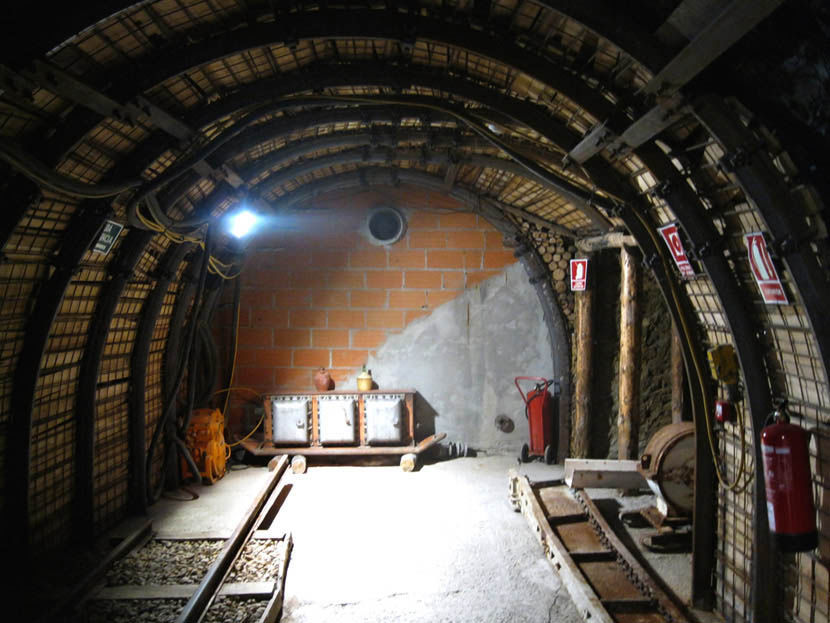
It is worth mentioning in this audioguide the mining material that we see on our route such as the “little skunks”, the small wagons that were used to transport just tools, we can also see supporting rods, electrical boxes, water pumps....
BERRY
Before we end our visit Berry bids us farewell, a single cabin locomotive in which we can observe the peculiar manner in which the machinist had to control the engine, he had to be on his side! The machine was made in 1942, in France and also used diesel as fuel.
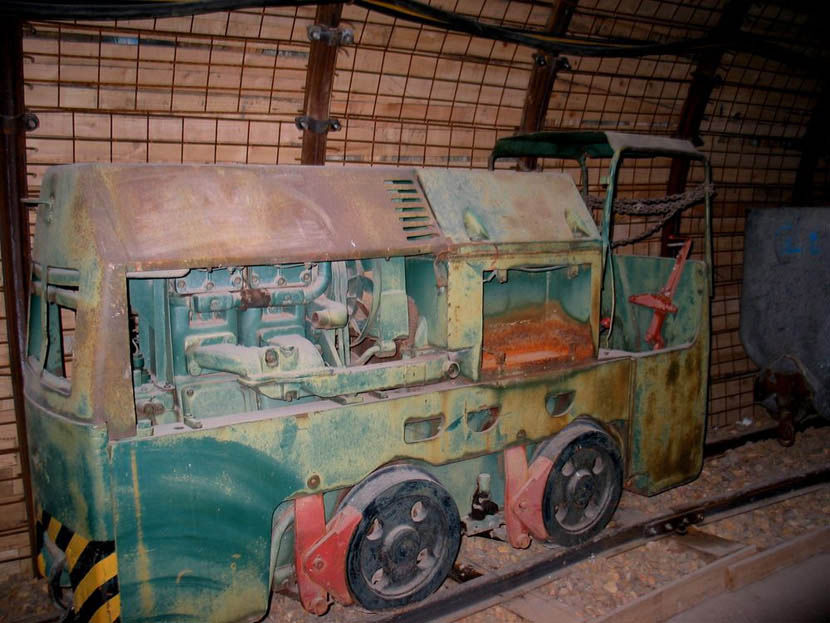
Here we end our trip, in which we have attempted to transport you the visitor backwards in time with the help of this audioguide, bringing you close to the mining world and its way of life and introducing you to those miners who gave everything, including their lives, in these mines. See you later!!!
Bluehertz Audio guides has developed for Puertollano's Mining Museum an audio guide service avaliable in Spanish and English languages.
Puertollano's Mining Museum address: Parque del Pozo Norte, 13500 Puertollano, Ciudad Real.
- Tel.: 926 44 02 75 - museomineria@puertollano.es -
Back to Index